USST_Arts_112480745基于供需网特征理念的企业间关系状态研究
VIP免费
摘 要
随着科技的进步和经济的发展,以全球资源获取、全球制造、全球销售为根
本特征的全球经济一体化格局已逐渐形成。传统单纯的竞争性经营战略已经不能
满足现代企业生存与发展的需要,即企业经营须由“以竞争为主”向“以合作为
主、竞争为辅”的战略转变。正因如此,多功能开放型企业供需网(简称供需网)
强调多功能性合作、充分开放性合作、包容性合作和动态网络性合作的基本特征,
这些特征从不同的角度显示了供需网企业间以合作为主(竞争为辅)的经营战略。
很显然,在新的市场环境下,由于企业必须摒弃传统理念支配下的竞争性为
主的经营战略,导致企业间关系具有很强的动态复杂性,企业相互之间也因此而
存在较之以往更复杂的博弈关系。因此,企业间关系研究与管理会成为当今企业
管理研究的重要组成部分,即如何采用科学的理论和方法定性定量研究企业间竞
争、合作、中立等关系状态变得重要起来,本文的研究是定性定量研究企业间关
系的一部分。
本文作为国家自然科学基金项目《基于供需网基本特征理念的企业合作优化
模型方法研究(项目批准号:71171135)》研究的组成部分,将基于供需网的特征
理念,将企业间关系视为从竞争到合作的连续谱系,并运用因子分析法等理论和
方法讨论企业间关系强度的衡量指标,借此对企业间关系强度和关系状态进行定
量与定性相结合的研究。本文主要的研究工作如下:
(1)介绍了基于供需网基本特征理念的相关概念,讨论了研究企业间关系状
态的目的和意义,并分析了国内外相关的研究现状。
(2)由于企业间除了竞争和合作关系外,还有中间关系状态的存在,因此,
文章基于供需网理念将企业间关系分为三类,即合作关系、中间关系和竞争关系,
并描述了企业间的这三类关系状态,进而将企业间关系状态视为连续的谱系,构
建了基于供需网理念的企业间关系状态谱系模型。
(3)运用文献调查法和因子分析法等方法和理论,构建了企业间关系状态评
价指标体系。
(4)讨论了企业间关系状态评价指标权重确定的方法,采用层次分析法等求
解企业间关系状态评价指标体系的权重值。
(5)根据理论结合实际的原则和所建立的模型方法,把相关企业作为案例,
并收集数据进行了分析。
随着经济日益全球化复杂化,当今企业管理面临了更多不确定的因素,科学
地了解与相关企业间的关系状态将有利于企业在复杂环境中的生存与发展。本文
将企业间关系状态视为连续的谱系,并量化研究了企业间关系状态,因此可为创
新型的企业关系管理决策提出理论和方法支撑——这可能是本文研究的意义所在。
关键词:供需网 企业关系 关系状态
ABSTRACT
With the development of technology and economy, global economic integration
characterized by global resources access, global manufacturing, global sales has been
gradually formed. Traditional competitive business strategy can not satisfy the need of
modern enterprise for survival and development. It means that business strategic shall
be converted from the ‘competition-oriented’ to ‘Mainly based on cooperation,
supplemented by competition’. For this reason, multi- enterprise supply and demand in
an open network (referred to as SDN), which emphasizes the versatility, openness,
inclusiveness of collaboration in the dynamic network. These features show the SDN
enterprise’s main (competition supplemented) business strategy from different
perspectives.
Obviously, in the new market environment, as companies must abandon the
traditional competition-oriented business strategy. This leads to its relations with strong
dynamic complexity, and thus also made a more complicated relationship among
enterprises .Therefore, the research of the relationship between enterprises will become
an important part of today's business management studies, namely, the use of scientific
theories and methods to research competitive, cooperative, neutral status between
enterprises qualitatively and quantitatively becomes an important step to research
enterprise relationship.
This paper is part of the National Natural Science Foundation project
‘Optimization Model research Based on SDN basic features (Grant No.71171135).’
Based on the concept of SDN, the relationship between enterprises will be considered as
a continuous line from competition to cooperation, and this paper discusses the strength
of relationship between enterprises by using factor analysis and other methods, whereby
the research for the strength of the relationship between enterprises in scientific theories
combined quantitative and qualitative analysis. The main research works are as follows:
(1) Describes the basic features of SDN, discusses the purpose and significance of
the relationship between the research enterprises, and analyzes the research status
related at home and abroad.
(2) Apart from the competition and partnerships, there exists an intermediate state
of relations between enterprises, therefore , the article will be based on the concept of
SDN, and divides relationships between enterprises into three categories, namely
partnerships, competition and the middle relationship, and the relationship between
enterprises will be considered as an continuous line from competition to cooperation, to
construct a model of enterprise relationship status based on the concept of SDN.
(3) To construct the state of relationship between enterprises evaluation system by
using literature survey and factor analysis and other methods and theories.
(4) To discuss weight determination methods for the evaluation index, of state of
relationship between enterprises such as AHP weights for solving inter-enterprise
relationship status evaluation system.
(5) Established model combined with the theoretical principles and practical
methods, collect the data to do a case study.
With an increasingly globalized and complicated economy, the management of
current enterprises are facing more uncertain factors. It will benefit enterprise’s survival
and development in the complex environment with understanding the state of
relationship between related companies scientifically. In this paper, the relationship
between enterprises will be considered as a continuous line from competition to
cooperation, and it is quantified. Therefore it proposed support for innovative enterprise
relationship management with theory and methods - this might be the significance of
this study.
Keywords: supply and demand networks, corporate relations,
relationship status
目 录
摘 要
ABSTRACT
第一章 绪 论 ....................................................... 1
1.1 研究的背景与意义 .............................................. 1
1.1.1 研究的背景 ................................................ 1
1.1.2 研究的意义 ................................................ 2
1.2 国内外研究现状 ................................................ 3
1.2.1 企业间竞合关系研究现状 .................................... 3
1.2.2 供应链和供需网的研究现状 .................................. 4
1.3 研究思路与结构安排 ............................................ 6
1.3.1 研究内容 .................................................. 6
1.3.2 研究方法 .................................................. 7
1.3.3 结构安排 .................................................. 7
1.4 本章小结 ...................................................... 8
第二章 相关理论研究综述 ............................................ 9
2.1 多功能开放型企业供需网(SDN)的基本概念 ......................... 9
2.1.1 SDN 的来由 ................................................ 9
2.1.2 SDN 的基本特征 ............................................ 9
2.1.3 SDN 的结构模型 ........................................... 10
2.2 企业间竞争、合作、中间等三类关系的相关概念 ................... 11
2.2.1 企业间合作关系 ........................................... 11
2.2.2 企业间中间关系 ........................................... 14
2.2.3 企业间竞争关系 ........................................... 15
2.2.4 企业间竞合关系的理解 ..................................... 16
2.3 本章小结 ..................................................... 17
第三章 企业间关系状态的评价指标体系 ............................... 18
3.1 企业间关系状态评价指标体系的构建 ............................. 18
3.1.1 企业间关系状态评价指标体系构建思路 ....................... 18
3.1.2 因子分析法 ............................................... 18
3.2 基于供需网理念的企业竞争合作关系强度(SDNR) ................... 18
3.2.1 基于供需网理念的企业竞争合作关系强度(SDNR)的内涵 ......... 18
3.2.2 企业竞争合作关系强度(SDNR)谱系的节点 ..................... 19
3.2.3 企业竞争合作关系强度(SDNR)谱系的内容 ..................... 21
3.3 企业间关系状态衡量指标 ....................................... 22
3.3.1 企业关系状态评价指标体系理论 ............................. 22
3.3.2 企业关系状态评价指标体系的科学构建 ....................... 24
3.4 本章小结 ..................................................... 28
第四章 企业间关系状态指标权重确定与取值标准 ....................... 29
4.1 关系状态指标权重确定方法 ..................................... 29
4.2 层次分析法 ................................................... 29
4.2.1 层次分析法(AHP)原理 .................................... 29
4.2.2 层次分析法确定权重步骤 ................................... 29
4.3 指标体系指标取值方法 ......................................... 33
4.3.1 德尔菲法 ................................................. 33
4.3.2 问卷调查法 ............................................... 33
4.4 指标体系指标取值标准 ......................................... 34
4.4.1 互动强度 ................................................. 34
4.4.2 感情深度 ................................................. 35
4.4.3 互惠强度 ................................................. 35
4.4.4 资源依赖强度 ............................................. 36
4.5 本章小结 ..................................................... 36
第五章 案例研究 ................................................... 37
5.1 企业背景资料 ................................................. 37
5.1.1 对象企业 A背景介绍 ....................................... 37
5.1.2 企业 A的相关企业 B公司背景介绍 ........................... 37
5.1.3 企业 A的相关企业 C公司背景介绍 ........................... 37
5.2 企业 A与相关企业间关系状态评价 ............................... 37
5.2.1 主观权重的确定 ........................................... 38
5.2.2 企业 B和企业 C与企业 A关系状态指标取值 ................... 41
5.2.3 企业 B和企业 C与企业 A关系状态指标求解与分析 ............. 44
5.3 本章小结 ..................................................... 44
第六章 总结与展望 ................................................. 45
6.1 研究总结 ..................................................... 45
6.2 展望 ......................................................... 45
参考文献: ........................................................ 47
相关推荐
-
上海市回民中学2022-2023学年(五四学制)六年级上学期期中语文试题(原卷版)VIP免费
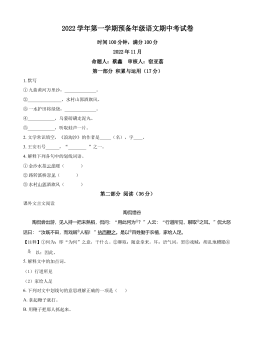
 2024-09-24 9
2024-09-24 9 -
上海市回民中学2022-2023学年(五四学制)六年级上学期期中语文试题(解析版)VIP免费

 2024-09-24 8
2024-09-24 8 -
上海市黄浦区2022-2023学年(五四学制)六年级上学期期中语文试题(原卷版)VIP免费

 2024-09-24 7
2024-09-24 7 -
上海市黄浦区2022-2023学年(五四学制)六年级上学期期中语文试题(解析版)VIP免费
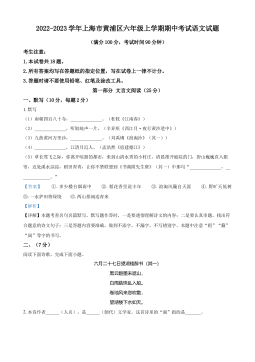
 2024-09-24 7
2024-09-24 7 -
上海市长宁区2020-2021学年六年级上学期期末语文试题(原卷版)VIP免费
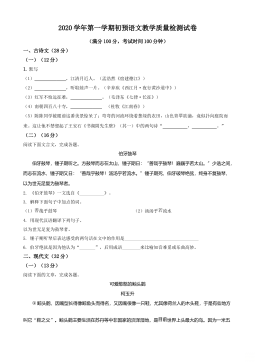
 2024-09-30 8
2024-09-30 8 -
上海市长宁区2020-2021学年六年级上学期期末语文试题(解析版)VIP免费
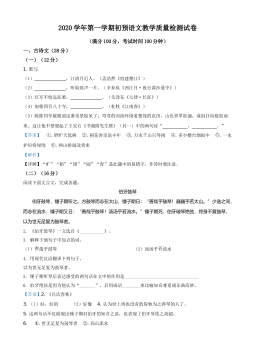
 2024-09-30 9
2024-09-30 9 -
上海市杨浦区2020-2021学年六年级上学期期末语文试题(原卷版)VIP免费
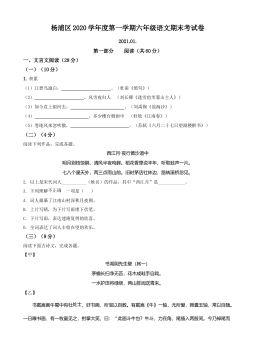
 2024-09-30 7
2024-09-30 7 -
上海市杨浦区2020-2021学年六年级上学期期末语文试题(解析版)VIP免费
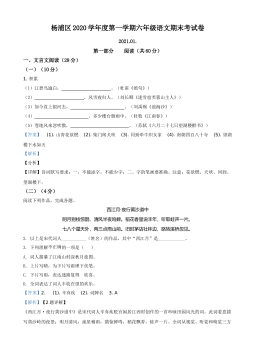
 2024-09-30 10
2024-09-30 10 -
上海市徐汇中学2020-2021学年六年级(五四学制)上学期12月月考语文试题(原卷版)VIP免费
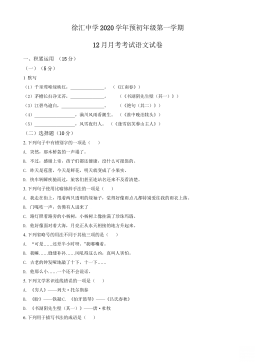
 2024-09-30 7
2024-09-30 7 -
上海市徐汇中学2020-2021学年六年级(五四学制)上学期12月月考语文试题(解析版)VIP免费
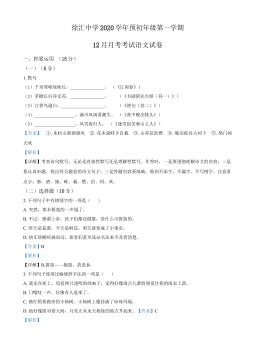
 2024-09-30 8
2024-09-30 8
作者:赵德峰
分类:高等教育资料
价格:15积分
属性:63 页
大小:2.94MB
格式:PDF
时间:2025-01-09
作者详情
相关内容
-
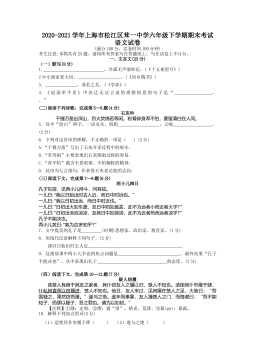
上海市松江区2020-2021学年六年级下学期期末考试语文试卷
分类:中小学教育资料
时间:2024-09-30
标签:无
格式:DOCX
价格:5 积分
-
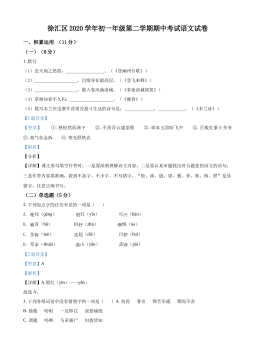
上海市徐汇区2019-2020学年六年级(五四学制)下学期期中语文试题(解析版)
分类:中小学教育资料
时间:2024-09-30
标签:无
格式:DOCX
价格:5 积分
-
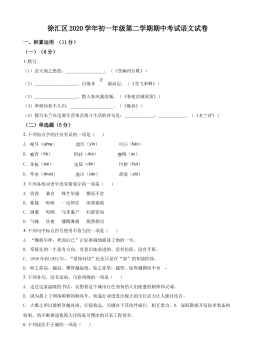
上海市徐汇区2019-2020学年六年级(五四学制)下学期期中语文试题(原卷版)
分类:中小学教育资料
时间:2024-09-30
标签:无
格式:DOCX
价格:5 积分
-
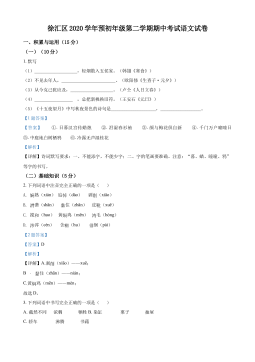
上海市徐汇区2020-2021学年(五四学制)六年级下学期期中语文试题(解析版)
分类:中小学教育资料
时间:2024-09-30
标签:无
格式:DOCX
价格:5 积分
-
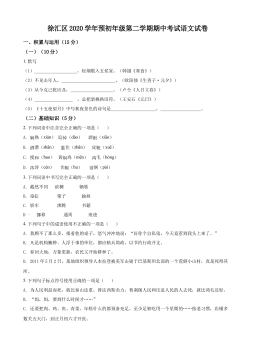
上海市徐汇区2020-2021学年(五四学制)六年级下学期期中语文试题(原卷版)
分类:中小学教育资料
时间:2024-09-30
标签:无
格式:DOCX
价格:5 积分






